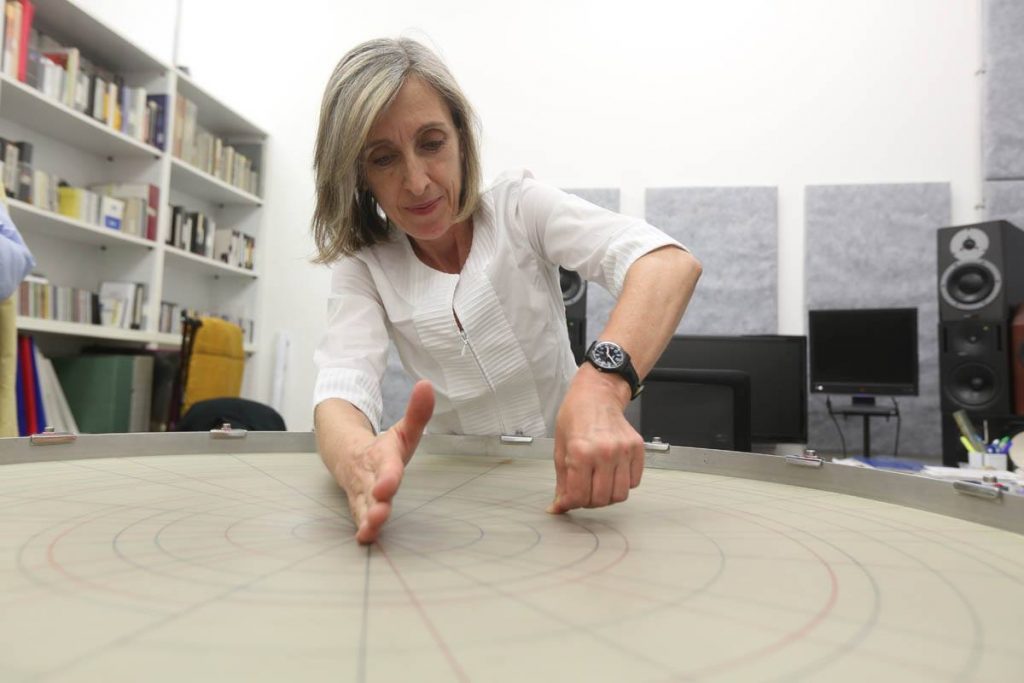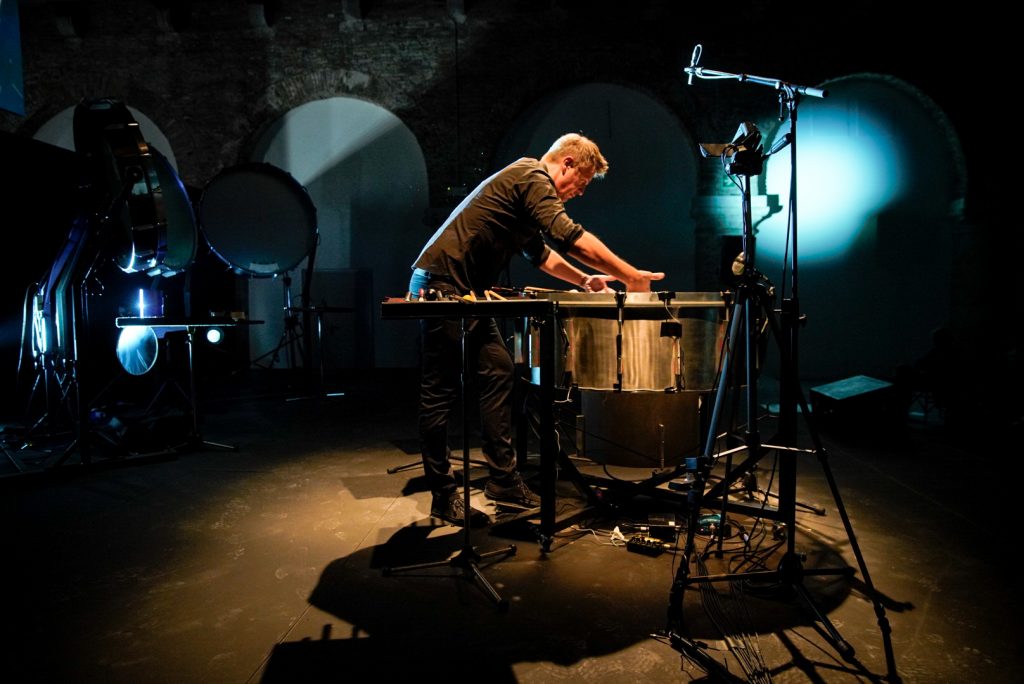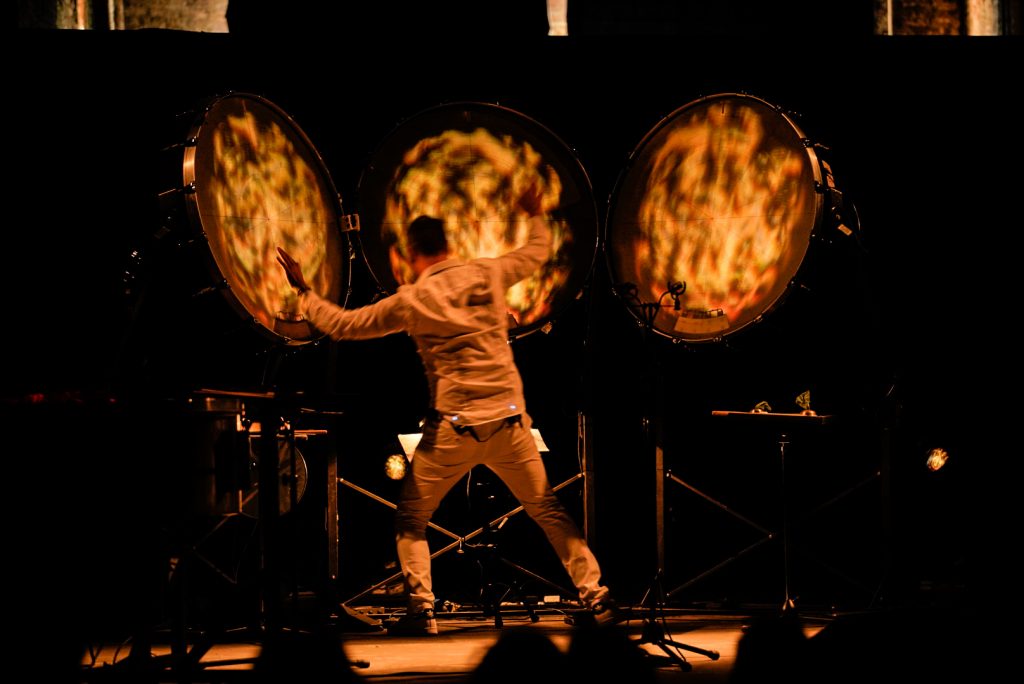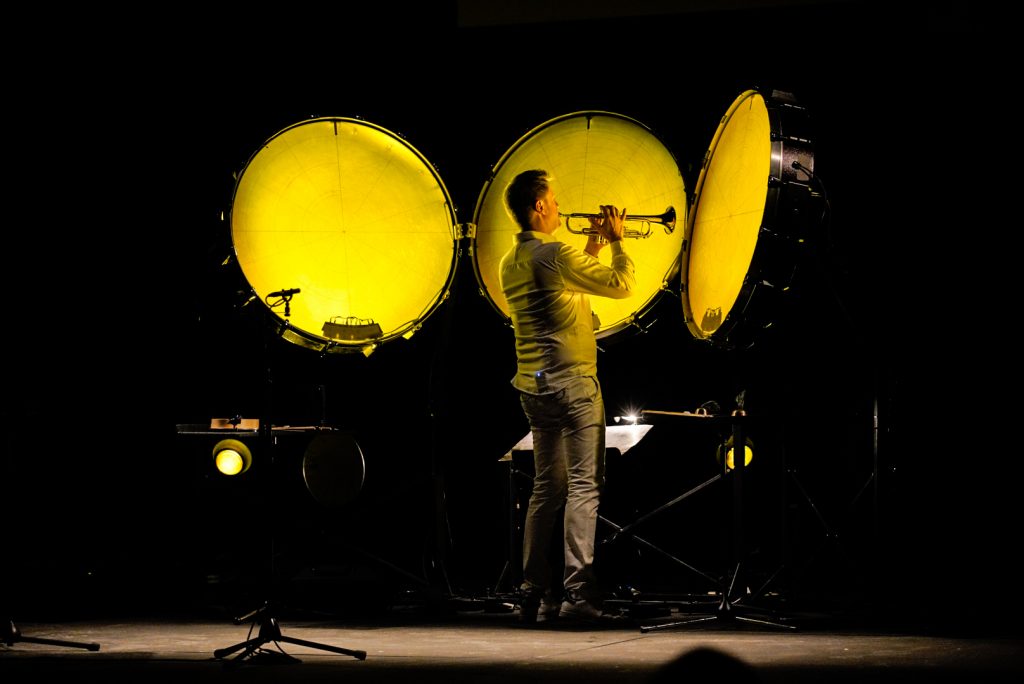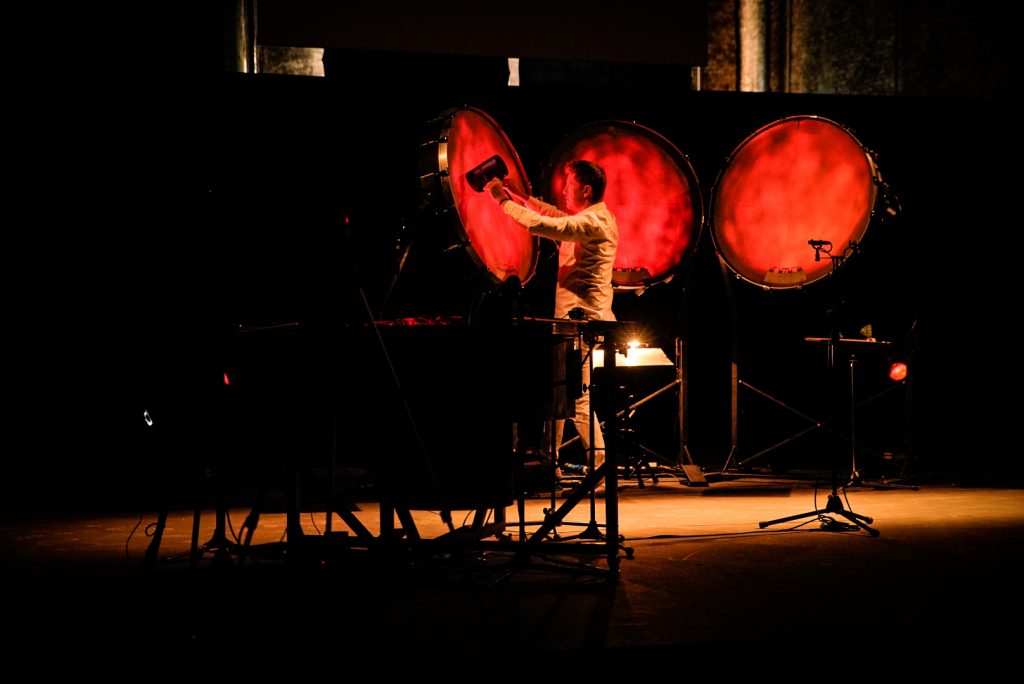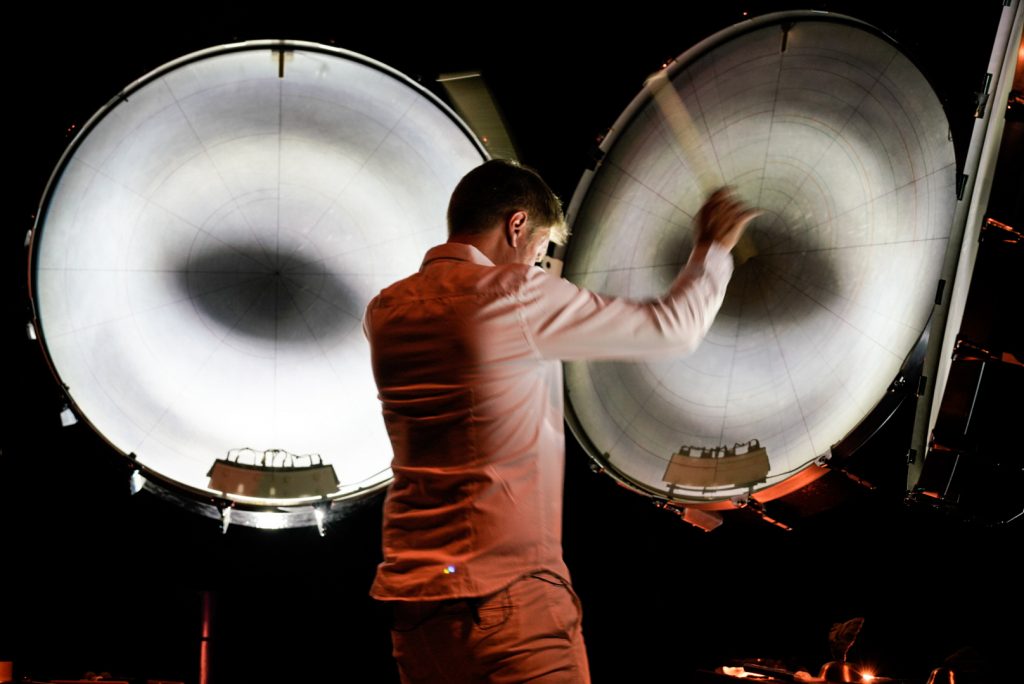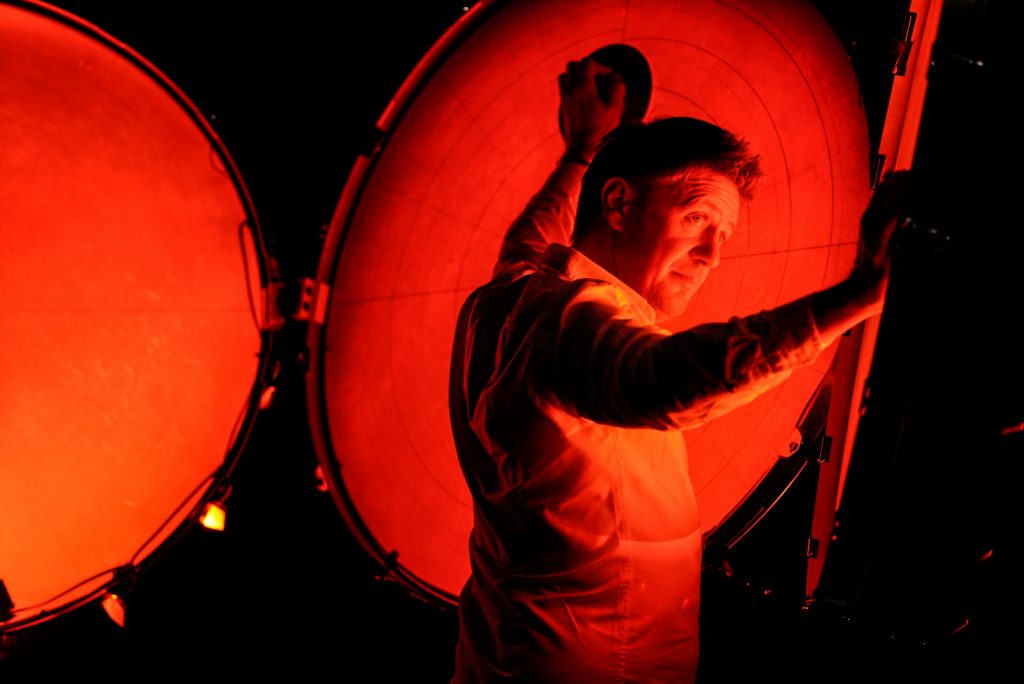Freely inspired by the poems of Anna Maria Mazzoni’s Mediterranean collection, Luna Doppia is a short but intense and absolutely celestial piece that collects ancient sounds (and never heard sounds) able to ‘acoustically reproduce’ the moon’s shine on water, on surfaces. And much more: every listening soul will resonate with those nine minutes composed with the computer. Each according to their own experience following the sensations that it inspires.
Rather than reproducing that moonlight, Luna Doppia imagines it and creates it because obviously this phenomenon, itself, has no sound: if anything, to eventually sound can be a ‘pattern’ of the landscape in which we happen to observe the shine. It is a composition with strong ‘spatial’ qualities that allows the mind to imagine a journey in that trail of light. That I think many of us have at least once wanted to own.
It is an experience with thaumaturgical qualities, which even touches on certain areas of care that I consider similar to shamanism or in any case to an unusual – for our traditions – experience of deep care. Of the mind, of one’s own experiences and of certain obsessions.
I could not but meet who that piece composed, Ms Laura Bianchini (composer born in Trevi in Lazio, Italy, in 1954), to find out who she is and where she came from.
Do you come from a family of musicians …?
No not at all. Mountain peasants, until we moved to Rome at the beginning of the Sixties. Very determined and tested by the toil of work.
No frills, no indulgence towards other things, no …
Nothing, absolutely nothing.
Not even culture?
Culture yes. I owe a lot to my parents and especially to my paternal grandmother who is a person who unfortunately has not had the opportunity to study given the years in which she lived. Women, especially, did not have much chance but she learned to read (and write) alone. Over time she has cultivated her passions – of course, reading the Missals and what little she found.
She gave me communication skills through the storytelling because she was very good at it and I was listening to her for hours. I have cultivated this dimension of listening for a long time. And I owe everything to her.
The percussion of the drum, perhaps the most ancestral sound, is very linked to the transmission of knowledge. In many countries of oral culture the ‘living library’ wandering to tells stories uses these sounds to draw attention to listening. From shamanism to certain rhythms that can caress the diaphragm to such a point that we operate ‘physical’ involvement of our body (especially for low and overbearing sounds) up to the ‘oneiric’ level of our involvement ….
I worked a lot on this, writing other pieces for percussions that start from this idea of shamanism but above all from that of ancestral sound, the need to express themselves through rhythm, especially the rhythm of percussion that in some way is associated even if in a manner different to biological rhythms. And that therefore manages to awaken the conscience and the ancestral ‘stories’. We work on the archetype, on what are the foundations of human existence and that each of us carries as baggage both in our own DNA and in the ‘cultural’ one.
How did you get to music as a profession from that peasants family background?
Meanwhile, through the determination that is typical of these people: above all, mountain farmers struggle a lot to get a minimum result. Even almost a challenge to overcome the limit, the difficulty. And then, the music has always accompanied me. I participated in choirs from the first class until maturity and I have always practiced it even if in amateur forms.
Since there was no specific culture about music, my family considered it as a pleasure not as a profession. And I grew up with this conviction: I started, very young, to work in a multinational company but from the first day I told myself that I would not stay there long.
I met some people who helped me to start music studies and luckily I recovered my gaps quickly.
I immediately oriented my studies towards composition because I had a funding expressive need. Although I have never dealt professionally with music in my youth, in my past I have always gone through all the arts (from literature to painting). Finally, among the arts is the music that has ‘kidnapped’ me.
Have you always had an avant-garde touch? Have you always had more inspirations to the kind of Cage than to Boulez for inspiration?
No, I never thought about writing music with one or the other composer as a reference. I consider great either Cage and Boulez but I always thought I had to start with new, uncoded tools. I started with a creative necessity that challenged the language, and for this reason I dedicated myself to the study of composition according to the experimental school and to electronic music. It is a kind of tabula rasa that allows you not to have preconceptions and ideas or schemes formed. At the same time I did the classical music studies required for each composer: Harmony, Piano, Reading of the score, History of music …
Your music is able to switch from ambient to a myriad of other styles or definitions in a single ‘song’ (which is perhaps not a suitable word as it is not the most used one, ‘composition’). I could try ‘a piece of life’ because you rush the listener into something ‘unheard’ yet close. In a very deep state. That said, you manage to have and have no pre-formatted style, by always remaining in the electronic field. Can you tell us more?
This is very true. I start from an expressive need and my themes are of an existential nature and inevitably affect everyone. I start from an idea or a sound event that stimulates an idea and I try, by deepening it, to outline contents, forms and technologies to be used. It is a research that requires not only the study of the most suitable materials and tools, but also the modes of artistic communication, the context, the space of diffusion because the modes of fruition are part of the process of artistic communication. Psycho-acoustics (a discipline that studies the subjective human perception of sound), is of great support and offers important information that allows the composer to calibrate the musical elements put into play. Among my studies in the past there was also that of psychology that allowed me a simple and natural approach to a certain type of artistic communication, which to be such, must involve the emotional level.
A lot of work is needed to stir up emotion.
But you know alchemy, you manage to project someone wherever you want. It is so powerful the effect that you manages to give that I have to say that you knows something more and is not only an exercise in style (albeit masterly), you touch specific strings with sounds. Is it part of ‘psycho-acoustics’? I start to think at this point that it can also be something terribly dangerous …
Mine is a research work, I try to understand what and how to communicate a thought. Yes, psycho-acoustics is important, of course, depends on how it is used but it is not enough.
I push myself a little further.
The expressive need also arises from a need to go out a bit ‘from oneself’ and share an experience of existential pain that for what concerns me was and still is strong.
Through music I can sublimate this aspect of pain and open it to other conditions. My songs are not dramatic, or at least not all! I would say that there are also very funny, catchy compositions and some are also composed for children: even these songs were designed to accommodate a deep involvement both of the interpreter in the first person and of the public, of course.
When composing, you will use writing instruments very different from the ones of other composers … At the # BiennaleMusica2018 your interpreter – Philippe Spiesser – has also played in the second piece with a myriad of ’emitting’ objects that have been cleverly orchestrated (without talking about your ’increased’ drums…). You have created a series of completely unusual sound moments. What signs do you use to write them on the score and how did you decide that kind of cloth, tube, glass bead … .and any kind of played objects … should be put that way?
It is an alchemy but the most important thing is the idea.
Especially in Luna Doppia after reading the poem that inspired me, I immediately understood the shape of the work and wrote it in a very short time. I wrote it using concrete and electronic sounds. The materials are varied and are also taken from small sounds of things, small objects (widely processed) and pure electronic sounds that obviously create the glue.
Which software do you use?
In the first phase, when Michelangelo Lupone and I founded CRM, the systems we had created, the Fly 10 and the Fly 30 were able to work in real time generating sounds but also using very sophisticated controls. In the case of Fly 30 also to process them because it is able to guarantee a very high numerical precision that allowed the use of complex algorithms such as digital filtering in real time.
For example, in my 1991 composition Open Universes I used 13th and higher filters for piano processing, which allowed the ‘percussive’ sounds typical of the instrument to extend resonances and to be modulated, thanks to this processing technique. It was a very important experience. Now I use various systems that the market makes available, it does not really matter what do you use but the awareness of the medium you are using to get the desired result.
The ‘augmented’ drums you just brought on stage are a sort of ‘controlled beast’ as Michelangelo says. I imagine them played in their fullness. Have you ever tried to give the power of these objects you created an ‘aim to care’ or a physical sensation?
Of course! We have developed a program called ‘Musica-Emozioni’ with the Tor Vergata University (specifically with the Psychiatric Unit of the Policlinico) that works with patients with psychiatric disability. We organized meetings and internships to see if the innovative sculptural-musical forms of art and the use of an interactive tool such as the Feed-Drum® made at CRM could stimulate psychiatric patients, especially schizophrenics, for whom the the biggest problem is relationship and communication with each other.
Through these internships we have tried to stimulate a reaction in these people.
The experimentation has continued for seven years. The program is still carried out in the form of ‘internships’ because research has no funds, an important team is needed that works continuously to carry out this project.
The results were excellent. Patients came who did not speak before entering the ‘stage’. One in particular emitted only a whistle, did not speak and did not answer – whatever you told him. After one year, this patient was another: you were talking to us, answering everything, asking questions. He also told us why he liked the instrument. A crazy thing! This is also thanks to the kind of work done by Tor Vergata technicians who daily treat patients not only with drugs but through artistic activities (music, theater and others).
When do you listen to music that is not yours, what does you listen to?
Everything. Meanwhile, there is a professional distortion: one can not but listen, so this aspect also comes into play.
But if you do not take an involvement and a participation in listening then it means (for me, of course) that something is missing and I stop listening, after a while I get bored.
And when you travel by train: what do you bring with you to listen to?
No music. I prefer to read.
So, which is the last book in your hands?
C’entra poco con la musica: è un libro che si occupa del benessere delle persone – autore un medico italiano che ha sviluppato una sua teoria sull’alimentazione e sulla dieta. Una cosa che mi ha preso molto.
Sono eclettica, spazio da una cosa all’altra senza soluzione di continuità, leggo di tutto, quando posso. La poesia l’ho scoperta tardi ed è stata una folgorazione, ho scritto anche qualcosa ma non le ritengo ‘poesie’. Sono considerazioni scritte in forma aforistica.
It has little to do with music: it is a book that deals with the wellbeing of people – the author is an Italian doctor who has developed his own theory about nutrition and diet. One thing that took me a lot.
I am eclectic, I space from one thing to another without interruption, I read everything when I can. I discovered poetry very late and it was simply eureka, I also wrote something but I do not consider it ‘poems’. These are written considerations in an aphoristic form.
Italian public broadcaster RAI has published a record of your compositions together with writers ….
Rai launched the initiative. It consisted of sixteen radio-films made by composers in collaboration with writers who were broadcasted on the radio. Michelangelo worked with Enrico Palandri and myself with Susanna Tamaro (before she became famous) on an extraordinary text called Per voce sola that she rewrote after each one has reread it on her own by noting significant steps. I then put it to music after working on the script. Our works have been published on CD, together with those of three other composers, by the Edi-Pan publishing house in Rome and also taken to the theater in a scenic form.
Does psycho-acoustics have research funds?
Not many, in Italy nothing. We have had the opportunity to face an in-depth study on psycho-acoustics during a commission for the automobile industry in the context of two three-year European research projects (to study the quality and the control of noise in cars). It allowed us to acquire useful knowledge for our experiments. We have recently had other projects but there is no continuity.
Sponsors, supporter? Who are the clients asking for compositions?
Without a shadow of misunderstanding, the clients are essentially foreigner. In my case especially French, the most active and sensitive to contemporary music.
Where can we buy your music, for example Luna Doppia is unpublished …
Through the CRM, where you can create your own collection. We do not have a publisher. With the radio movies we have it but has never bothered to publicize and promote this work ….
We have therefore decided, I in particular, not to have a publisher. Those interested in our work can contact us directly.
What did you learn so far from life?
A lot of things. You learn a lot by growing up.
Surely I have learned to have more confidence in me. An important job that has lasted many years.
– – –
Laura Bianchini collaborated in the creation of electronic systems for music, including the Fly10 in 1983, one of the first Italian digital systems for real-time sound synthesis designed by Michelangelo Lupone (his partner in CRM, Centro Ricerche Musicali).
Her musical production includes instrumental, electronic and radio works.
For several years she worked on the relationship between text and music and on the musical fairy tale collaborating with writers and directors (Susanna Tamaro, Giorgio Pressburger, Gustavo Frigerio, Ida Bassignano, Luca Ronconi).
Since 2003 her interest has increasingly focused on new forms of musical expression, such as sound installations of art, works that integrate the scenic space, listening to music and sound diffusion tools, using technologies designed at the CRM.
Winner of the “Arte sui Cammini” competition promoted by the Lazio Region in 2018 together with the artist Licia Galizia, she will realize the project “Via dei Canti”, three permanent sculptural-musical works along the St. Benedict’s Path to Trevi in Lazio.
Luna Doppia was the opening track – in absolute premiere – of a concert with three other CRM compositions at the 2018 Biennale Musica entitled Le chant de la matière.
To find out more: http://www.crm-music.it
#CrossingTheAtlantic
Laura Bianchini is portrayed by Iacobucci while playing a Feed Drum; the images of the P. Spissens’ performance of CRM drums and compositions are courtesy La Biennale di Venezia (ph. Avezzù)
